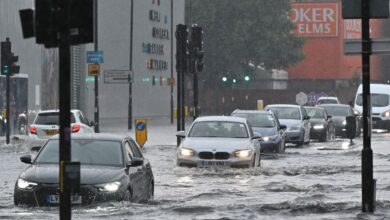Air pollution levels return after first ‘zero-emission street’ in UK scrapped

Levels of a harmful air pollutant have shot back up in an area of London that scrapped the “first 24/7 zero-emission street” in the UK, according to new research.
A road in the Barbican area saw nitrogen dioxide (NO2) levels fall sharply during a trial that stopped petrol and diesel vehicles from passing through, scientists have said.
In the first five months since this was scrapped, they found the concentration of the air pollutant around Beech Street rose back above the average for London roadsides.
Researchers from Imperial College London noted these levels were approaching the UK government’s air quality target limits.
“It raises concerns that should traffic continue to increase as the pandemic situation improves, it is more likely that this objective would be exceeded whereas it may have been met with the zero emissions restrictions in place,” the study said.
Last year, the EU’s top court found the UK had broken the law by “systematically and persistently” breaching its NO2 limits.
This air pollutant comes in a large part from traffic fumes. It can cause inflammation of the airways, exacerbate symptoms in people with pre-existing lung and heart conditions and increase susceptibility to respiratory infections and allergens.
Imperial College London researchers found NO2 levels around Beech Street fell by two-thirds when the zero-emissions zone first saw signs emerge in March 2020 telling motorists that only electric vehicles were allowed through.
This coincided with Covid pandemic restrictions, which saw an overall drop in traffic, the study said. However, the drop in NO2 concentrations was far greater at Beech Street compared to the London roadside average, which fell 38 per cent.
Between summer 2020 and autumn 2021, the street restrictions were enforced by automatic number plate recognition and penalty charges.
During this time, average NO2 concentration was 58 per cent lower than before restrictions came into force. This was again much greater than the average London roadside drop of 24 per cent.
When all restrictions were removed in September last year, researchers said average levels of the air pollutant increased and were once again higher than the London roadside mean.
Oliver Lord, from Clean Cities Campaign, told The Independent that the research commissioned by his group showed the trial to slash emissions was “working” before it was scrapped.
“It is very clear diesel vehicles in that area – especially in a tunnel like that – were playing a big contribution to the local air pollution,” he said.
Mr Lord, UK head of the campaign group, said: “We know those kind of schemes work and the electric vehicles were using the street.
“But I think it also shows local authorities can’t just end something like that and then sit on their hands for a considerable period of time because what we are talking about is people’s health.”
In the trial, only zero-emission vehicles, pedestrians and cyclists were able to pass through the street in central London in a bid to improve air quality in the local area.
The City of London council said the scheme was “the UK’s first 24/7 zero emission street” and would last for 18 months, with a chance of becoming permanent if successful. It ended in September 2021.
The council has been approached for comment.





